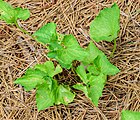Note: This is a project under development. The articles on this wiki are just being initiated and broadly incomplete. You can Help creating new pages.
Difference between revisions of "Vaccinium crassifolium - Creeping blueberry"
(→References) |
(→External Links) |
||
| Line 62: | Line 62: | ||
==External Links== | ==External Links== | ||
| − | * [https://www.wildflower.org/plants/result.php?id_plant=VACR | + | * [https://www.wildflower.org/plants/result.php?id_plant=VACR Vaccinium crassifolium on wild flower centre] |
| − | * [https://www.lifestyle.com.au/plant-guide/creeping-blueberry-6948.aspx] | + | * [https://www.lifestyle.com.au/plant-guide/creeping-blueberry-6948.aspx Vaccinium crassifolium on plant guide on life style] |
| − | + | ||
| − | * [https://myfolia.com/plants/79469-creeping-blueberry-vaccinium-crassifolium] | + | * [https://myfolia.com/plants/79469-creeping-blueberry-vaccinium-crassifolium How to grow Creeping Blueberry] |
| − | * [http://homeguides.sfgate.com/plant-blueberries-offshoot-suckers-49288.html] | + | * [http://homeguides.sfgate.com/plant-blueberries-offshoot-suckers-49288.html How to Plant Blueberries From Offshoot Suckers] |
[[Category:Herbs]] | [[Category:Herbs]] | ||
Revision as of 15:00, 4 May 2018
Vaccinium crassifolium, the creeping blueberry, is a species of Vaccinium in the heath family. It is native to the four southeastern U.S. states of Virginia, North Carolina, South Carolina, and Georgia. It is an evergreen shrub with shiny dark green to bronze leaves.
Contents
Uses
Gout, Longevity Tonics, Memory/Focus, Skin eruptions, Pimples, Diarrhea.
Parts Used
Chemical Composition
Phenolic compounds are a large class of phytochemicals that are widespread in the plant kingdom and known to have antioxidant capacities[1]
Common names
| Language | Common name |
|---|---|
| Kannada | |
| Hindi | |
| Malayalam | |
| Tamil | |
| Telugu | |
| Marathi | NA |
| Gujarathi | NA |
| Punjabi | NA |
| Kashmiri | NA |
| Sanskrit | |
| English | Blueberries , blueberry, huckleberry, ligonberry |
Habit
Identification
Leaf
| Kind | Shape | Feature |
|---|---|---|
| Simple | Pale yellow or ‘dirty’ green worms and Leaves are rolled and webbed together where insects feed. Eventually becomes skeletonized |
Flower
| Type | Size | Color and composition | Stamen | More information |
|---|---|---|---|---|
| Unisexual | 2-4cm long | Yellow | 5-20 | Flowers Season is June - August |
Fruit
| Type | Size | Mass | Appearance | Seeds | More information |
|---|---|---|---|---|---|
| 7–10 mm (0.28–0.4 in.) long pome | clearly grooved lengthwise, Lowest hooked hairs aligned towards crown | With hooked hairs | {{{6}}} |
Other features
List of Ayurvedic medicine in which the herb is used
- Vishatinduka Taila as root juice extract
Where to get the saplings
Mode of Propagation
How to plant/cultivate
Requires a moist but freely-draining lime free soil, preferring one that is rich in peat or a light loamy soil with added leaf-mould[3]
Commonly seen growing in areas
Garden Sunny Edge, Dappled Shade, Ground Cover.
Photo Gallery
References
External Links
- Pages that are stubs
- Ayurvedic Herbs known to be helpful to treat Gout
- Ayurvedic Herbs known to be helpful to treat Longevity Tonics
- Ayurvedic Herbs known to be helpful to treat Memory/Focus
- Ayurvedic Herbs known to be helpful to treat Skin eruptions
- Ayurvedic Herbs known to be helpful to treat Pimples
- Ayurvedic Herbs known to be helpful to treat Diarrhea
- Herbs with Fruit used in medicine
- Herbs with leaves used in medicine
- Herbs with common name in English
- Habit - Shrub
- Index of Plants which can be propagated by Seeds
- Index of Plants which can be propagated by Cuttings
- Herbs that are commonly seen in the region of Garden Sunny Edge
- Herbs that are commonly seen in the region of Dappled Shade
- Herbs that are commonly seen in the region of Ground Cover
- Herbs

